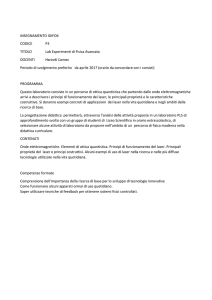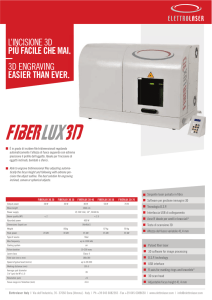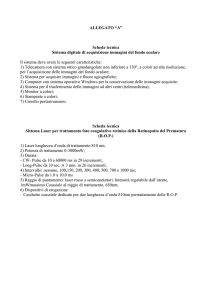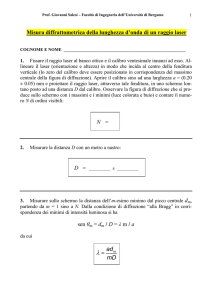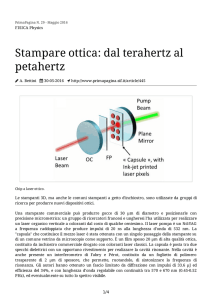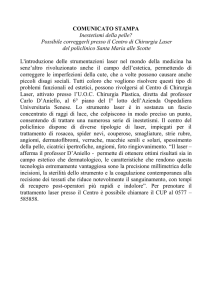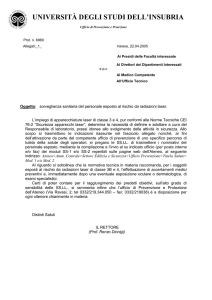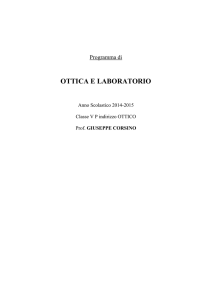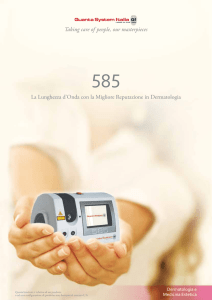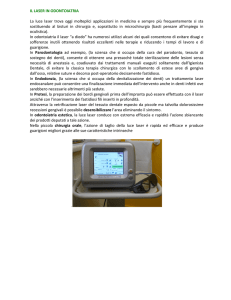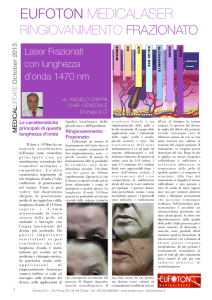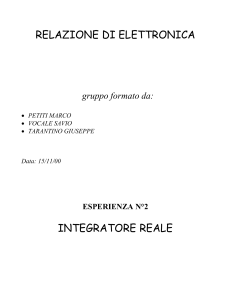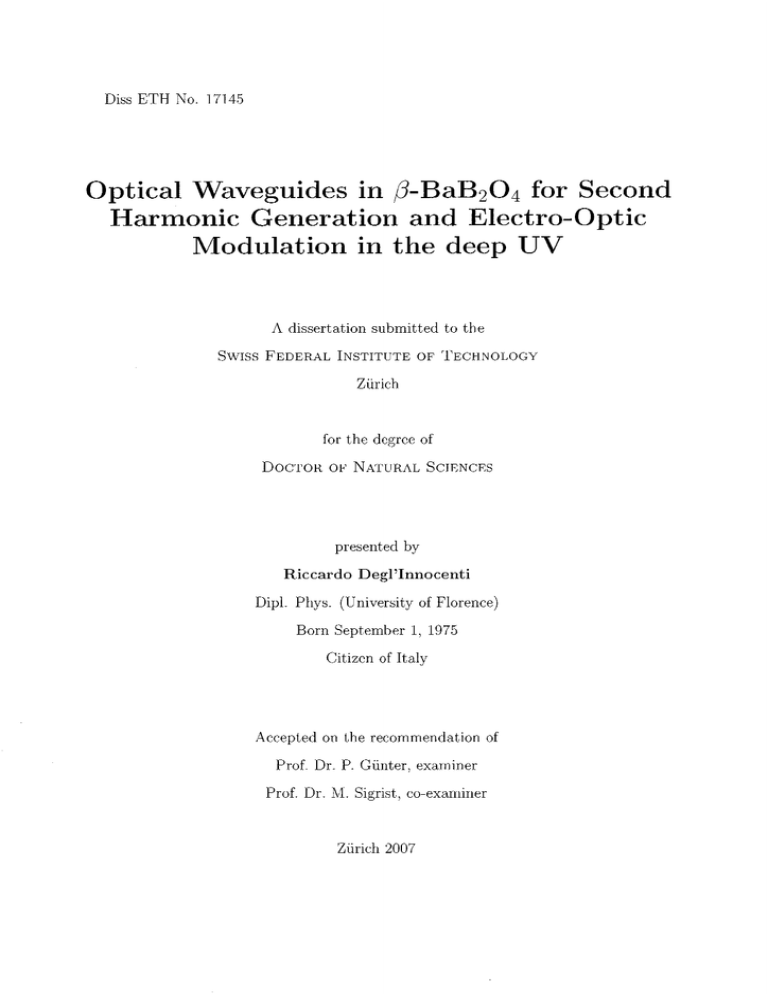
DissETH No. 17145
Optical Waveguidesin /?-BaB204 for Second
Harmonie Generationand Electro-Optic
Modulation in the deep UV
A dissertation submitted to the
Swiss Federal Institute of Technology
Zürich
for the
degree of
Doctor of Natural Sciences
presented by
Riccardo Degl'Innocenti
Dipl. Phys. (University of Florence)
Born September 1, 1975
Citizen of Italy
Accepted on the
Prof. Dr. P.
Prof. Dr. M.
reeornmendation of
Günter, examinier
Sigrist,
co-exaniiner
Zürich 2007
ABSTRACT
Abstract
Compact, continuous wave uitraviolet (UV) lasers are interesting for different applications,
as optical data storage, biomedical applications, fundamental spectroscopicresearch. laser
lithography. Since there are no diodedascrs emitting below 375 nm, the only way to
achieve this wavelength ränge consists in the optical frequency conversion of solid-statc
lasers in nonlinear crystals transparent in the UV, as /3-BaB204 (BBO). Channel waveguides, ma.intai.ning high power density over long interaction length, offer the possibility
of achieving high efiicieney in a single-pass seberne. Optical waveguides in BBO crystals
are very attractive for frequency conversion since they constitute the fundamentalpremise
for the realization of a compact all-solid-stalecontinuous
The main
goal
wave
UV laser.
of this thesis consisted in the fabrication of Channel
BaB204 for second
harmonic generation into the
waveguides in ß-
deep UV (below 300 nm).
Planar
wave¬
guides have been produeed in BBO crystals by He1' ion implantation and their linear and
nonlinear properties, have been accurately characterized. Two different techniques have
been successfully developed for the fabrication of Channels on these planar waveguides.
The first method consisted in the direct micromachining of the crystal surface using
femtosecond laser pulses. The second approachis based on photolithography and Ar"' ionsputtering. Both methods have been fully exploited and characterized. Particular attention
has been devoted to the identification of the different
sources
of transmission losses in
Finally, second harmonic generation has been demonstrated at 278 nm
with a maximum conversion efficiency of 0.1 % W_1 in a ridge-like waveguide, which
represents the first realization of a continuous-wave laser based on frequency conversion.
in waveguide, operating in the deep UV.
A similar strueturingtechnique has been applied to BBO crystals for the fabrication of an
electro-optic integrated amplitude moclulator, operating with a half-vvave voltagc times
length of 43 V-cm at 257 nm. This value represents a drastic improvement cornpared to
comrnercially available bulk BBO modulators, which are currentlyemployed for their high
these waveguides.
7
ABSTRACT
damage threshold and high frequency modulation capability (hundreds
are normally driven with typical half-wave voltages per length of few
important issue concerning
a
BBO
waveguide electro-optic
kHz), and which
kV-cm. Another
modulator is
represented by
the fact that such device could operate down to the transmission edge of BBO. at 190
nm.
These results also demonstratedthat in the future it could be
Converters and switchcs on the
same
possible, to combine optical
integrated optics platform
based on BBO.
RIASSUNTO
8
Riassunto
Lasers ad emissione continua nell'ultravioletto (UV) sono interessanti per diverse
appli-
cazioni, come ad esempio per immagazzinare dati ad alta densitä, applieazioni biomediche,
Dal niomento che
spettroscopia, litografia laser.
non
esistono diodi laser che emettono al
raggiungere queste lunghezze d'onda consistc nella
laser a stato solido in cristalli nonlineari trasparenti
di sotto di 375 nm, l'unico modo per
conversione ottica in
aH'UV,
di
ad
come
mantenere
offrono la
frequenza di
(BBO).
esempio il ß-BnB204
un'alta densitä ottica
Guide d'onda a canale. che
allo stcsso tempo
e
lunghe
distanze di
permettono
interazione,
possibilitä di ottenere un'alta efficienza in una configuraziorie di singolo passag-
guido d'onda in cristalli di BBO e qiiindi molto interessante per
la conversione ottica di frequenza, dal momento che costituisce la premessa. fundamentale
gio.
La realizzazione di
per la realizzazione di
un
laser di dimensioni ridotte. che possa emettere in onda continua
nell'ultravioletto.
Tl
principale
canale nel
questa
obiettivo di
tesi
/3-BaB204 per la generazione di
(lunghezze d'onda inferiori
di BBO tramitc
a
300
impiantazione
lavorazione diretta della
seconda armonica nel
nm). Guide d'onda piane sono State prodotte in cristalli
di ioni He"1
su
,
e
le loro
proprietä lineari
sviluppate con
state accuratamentestudiatc. Sono state
per la realizzazione di canali
guide d'onda a
profondo ultravioletto
consistito nella fabbricazione di
e
successo
e
nonlineari
due tecniche differenti
queste guide planari. II primo metodo
superficie del
cristallo tramite
sono
impulsi laser
a
consiste nella
femtosecondi. II
secondo metodo e basato invece sulla fotolitografia sulla corrosione tramite ioni Ar+. Le
potenzialitä
di entrambi i metodi
particolare,
e
di
stata dedicata
una cura
stata
il che
nm con una
Infine
e
di
un
emissione ncl
sempre basato
lunghezza di 43
V
x cm a
su
cristalli di
257 nm.
utilizzate. In
sorgcnti
stata dirnostrata la
generazione di se¬
una guida a canale,
laser in continua basato sulla, conversione
profondo
ultravioletto.
Sono state impiegate tecniche simili per la realizzazione di
integrato,
e
delle diverse
massimaefficienza di 0.1% W_1 in
rappresenta la prima realizzazione
frequenza in guida d'onda, con
eompletamente analizzaXe
speciale nell'individuazione
pcrdita in trasmissionein queste guido.
conda armonica, a 278
di
sono
BBO, in grado di
un
modulatore elettroottico
operare
con un
voltaggio per
Questo rappresenta un drastico miglioramento rispetto
9
RIASSUNTO
ai modulatori elettroottici non
piegati
integral i
per la loro resistenza ad alte
modulazionianche ad alte
commercio, normalmente
che si trovano in
potenze incidenti
frequenze (cenlinaia
di
per la loro
e
kllz),
e
im-
capacitä di seguire
che operano con
voltaggi
per
lunghezze tipicarncntc deirordine delle decine di kVolts. Un'altra importantecaratteristica
di un modulatoreelettroottico integrato fabbricato nel BBO, e rappresentata dal fatto che
un
tale
puo essere utilizzato fino al limite inferiore di trasmissione in
dispositivo
d'onda del
BBO, a
190
lunghezza
nm.
Infine, potrebbe essere possibile combinare sulla stessa piattaforma, basata su BBO, un
sistema
integrato
che includa un convertitore di frequenza
e un
interruttore ottico.

